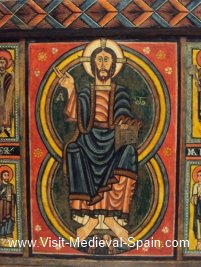Places to Visit in Catalonia (Catalunya)

BARCELONA
What to See:
Although Barcelona is perhaps most famous for the architecture of Antoni Gaudi and the pedestrianised avenue of Las Ramblas, the city has been settled since the neolithic era (8000 years ago) and has a large and impressive Gothic quarter (Barri Gotic) which is a labyrinth of narrow streets alleyways and plazas for the visitor to explore.
During Roman Times nearby Tarragona was the more important city, but during the middle ages the influence of Barcelona increased and the walled city grew in size to occupy the area that now includes the Barri Gotic and the Raval.
The medieval city wall was knocked down when the city expandad, all that remains today is a short section beside the Drassanes 13th Century Royal shipyards (now an interesting museum). Places of interest within the Barri Gotic include the 12th Century Cathedral, the nearby Plaza del Rei and Plaza Ramon Berenguer,the 14th Century Romanesque/ Gothic Basilica de Sta Maria del Mar, the medieval Jewish quarter and the 10th Century Església de San Pau church.
Two sites which should not be missed outside the Gothic quarter are the 14th Century Monestir de Pedralbes and the MNAC - Catalan National Art Museum, which houses and impressive collection of medieval artwork from across Catalonia and Aragon.
Our list of course excludes the large number of attractions which Barcelona has to offer which where built after the 15th Century !
Tourist Information: 0034 932853834
More information on our blog about Barcelona
How to get there:
- By Bus: Barcelona has frequent National and International bus services
- By Train: The city has frequent National and International train services including the AVE
- By Road: Motorways include the AP2 via Zaragoza to Madrid and the AP7-E15 North to France and South to Valencia etc.
- By Sea: There are ferry services to the Balearic Islands and Italy.
BESALU (GIRONA)
What to See:
Besalú is an attractive small medieval town in the region of the Garrotxa. In the middle ages however, it was an important capital of the county of Besalu. The town centre is a cluster of well preserved stone buildings, narrow streets and plazas. There is an 11th century Church of San Pau as well as the ruins of the Jewish baths andSynagogue. The best known sight in Besalú is the fortified Romanesque bridge across the River Fluvia, which was built between the 11th and 12th centuries.
Besalu can easily be visited as a day trip from Barcelona, Girona or the nearby Costa Brava but there are several hotels and restaurants if you should decide to stay.
Tourist Information: 0034 972590225
How to get there:
- By Bus: There are several buses each day to Besalu from Barcelona, Girona and Olot
- By Train: There is no train station in Besalu but there are frequent buses to nearby Girona where the bus station is right next to the Railway station.
- By Road: C66 via Girona to Barcelona or the N260 to Figeres and the Costa Brava.
PALS
What to See:
The picturesque medieval village of Pals was built on a natural vantage point overlooking the surrounding region of the "Baix Emporda" and the Costa Brava. The area was originally settled in Roman times but the beautifully restored gothic buildings that we can visit today were built between the 9th and 14th centuries. The village is small but has several good restaurants and makes a pleasant day trip from Barcelona or the Costa Brava. Places of interest include the 15th century Church of St Pere, the "Torre de Hores" watch tower and Visigoth tombs, the "Casa de Cultura Ca la Pruna" and the fortified city walls which are all that remain of the 9th century medieval castle of Pals. There are also splendid views of the surrounding area from the "Mirador Josep Pla", on a clear day you can see the Medas Isles.
Tourist Information: 0034 972667857
How to get there:
- By Bus: There are buses to Pals from Barcelona (3 per day) and Girona (1 bus daily) as well as local buses from nearby towns on the Costa Brava
- By Train: The nearest train station is Flaçà (aprox 20 km) which has local trains from Barcelona via Girona and on to Portbou.
- By Road: From Barcelona take the AP7 then the C35, (approx. 2 hrs depending on trafic)
VIC (Barcelona)
What to See:
Situated just 60km from Barcelona, Vic has been settled since the 4th Century BC when it was called Ausa and makes an interesting day-trip. The impressively large Plaza Mayor and surrounding "Casco antiguo" old quarter are an eclectic mix of architectural styles ranging from Gothic thru Baroque to "Modernista" ( The Spanish equivalent of Art Deco).
The best way to see the old city is simply to follow the clearly marked walking tour which starts from the Plaza Mayor and takes in the most important sights ( look out for signs labelled "Ruta Turistica" ). You can also pick up a map in the tourist office which gives details of buildings of interest along the route.
Highlights include the imposing Cathedral with its typically Catalan Romanesque Tower. The second Century Roman Temple which was incorporated into a castle when the medieval city of Vic was founded by Wilfred "the Hairy" in 897AD. The 11th Century Romanesque bridge, 14th century city walls and nearby Albergería, which served as a hostel for medieval pilgrims. Also of interest is the Episcopal museum which houses a large collection of Romanesque and Gothic religious art.
Tourist Information: 0034 938862091
How to get there:
- By Bus: There are frequent local trains to Vic from Barcelona (C3)
- By Train: Regular buses connect Vic with Barcelona and other local towns
- By Road: The C17 connects Vic with Barcelona and Ripoll,or the C25 to Girona and the Costa Brava
Ver Catalonia en un mapa más grande